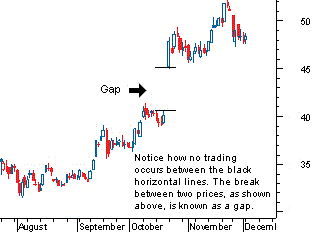ANALYZING CHART PATTERNS: GAPS
A gap in a chart is essentially an empty space between
one trading period and the previous trading period. They usually form because
of an important and material event that affects the security, such as an
earnings surprise or a merger agreement.
This happens when there is a large-enough difference in
the opening price of a trading period where that price and the subsequent price
moves do not fall within the range of the previous trading period. For example,
if the price of a company's stock is trading near Rs40 and the next trading
period opens at Rs45, there would be a large gap up on the chart between these
two periods, as shown by the figure below.
Gap price movements can be found on bar charts and
candlestick charts but will not be found on point-and-figure or basic line
charts. The reason for this is that every point on both point-and-figure charts
and line charts are connected.
It is often said when referring to gaps that they will
always fill, meaning that the price will move back and cover at least the empty
trading range. However, before you enter a trade that profits the covering,
note that this doesn't always happen and can often take some time to fill.
There are four main types of gaps: common, breakaway,
runaway (measuring), and exhaustion. Each are the same in structure, differing
only in their location in the trend and subsequent meaning for chartists.
Common Gap
As its name implies, the common gap occurs often in the
price movements of a security. For this reason, it's not as important as the
other gap movements but is still worth noting.
Common Gap
These types of gaps often occur when a security is
trading in a range and will often be small in terms of the gap's price
movement. They can be a result of commonly occurring events, such as low-volume
trading days or after an announcement of a stock split.
These gaps often fill quickly, moving back to the
pre-gap price range.
(to be contd)




No comments:
Post a Comment